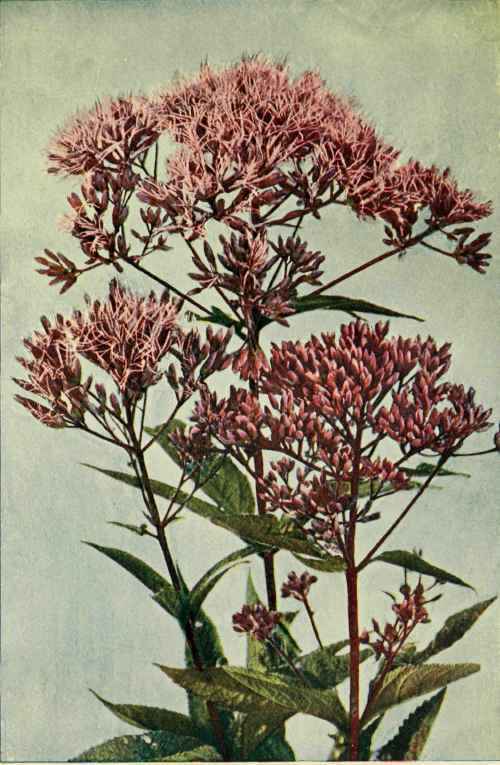Joe-Pye Weed; Trumpet Weed; Purple Thor-Oughwort; Gravel Or Kidney-Root; Tall Or Purple Boneset (Eiipatorinm Purpureum) Thistle Family
Description
This section is from the book "Nature's Garden", by Neltje Blanchan. Also available from Amazon: Nature's Garden; An Aid To Knowledge Of Our Wild Flowers And Their Insect Visitors.
Joe-Pye Weed; Trumpet Weed; Purple Thor-Oughwort; Gravel Or Kidney-Root; Tall Or Purple Boneset (Eiipatorinm Purpureum) Thistle Family
Flower-heads - Pale or dull magenta or lavender pink, slightly fragrant, of tubular florets only, very numerous, in large, terminal, loose, compound clusters, generally elongated. Several series of pink overlapping bracts form the oblong involucre from which the tubular floret and its protruding fringe of style-branches arise. Stem: 3 to 10 ft. high, green or purplish, leafy, usually branching toward top. Leaves: In whorls of 3 to 6 (usually 4), oval to lance-shaped, saw-edged, petioled, thin, rough.

Joe-Pye Or Trumpet Weed. (Eupat rium, purpureum.)
Preferred Habitat - Moist soil, meadows, woods, low ground.
Flowering Season - August - September.
Distribution - New Brunswick to the Gulf of Mexico, westward to Manitoba and Texas.
Towering above the surrounding vegetation of low-lying meadows, this vigorous composite spreads clusters of soft, fringy bloom that, however deep or pale of tint, are ever conspicuous advertisements, even when the golden-rods, sunflowers, and asters enter into close competition for insect trade. Slight fragrance, which to the delicate perception of butterflies is doubtless heavy enough, the florets' color and slender tubular form indicate an adaptation to them, and they are by far the most abundant visitors, which is not to say that long-tongued bees and flies never reach the nectar and transfer pollen, for they do. But an excellent place for the butterfly collector to carry his net is to a patch of Joe-Pye weed in September. As the spreading style-branches that fringe each tiny floret are furnished with hairs for three-quarters of their length, the pollen caught in them comes in contact with the alighting visitor. Later, the lower portion of the style-branches, that is covered with stigmatic papillae along the edge, emerges from the tube to receive pollen carried from younger flowers when the visitor sips his reward. If the hairs still contain pollen when the stigmatic part of the style is exposed, insects self-fertilize the flower; and if in stormy weather no insects are flying, the flower is nevertheless able to fertilize itself, because the hairy fringe must often come in contact with the stigmas of neighboring florets. It is only when we study flowers with reference to their motives and methods that we understand why one is abundant and another rare. Composites long ago utilized many principles of success in life that the triumphant Anglo-Saxon carries into larger affairs to-day.
Joe-Pye, an Indian medicine-man of New England, earned fame and fortune by curing typhus fever and other horrors with decoctions made from this plant. (Illustration, p. 138.)
Continue to:




